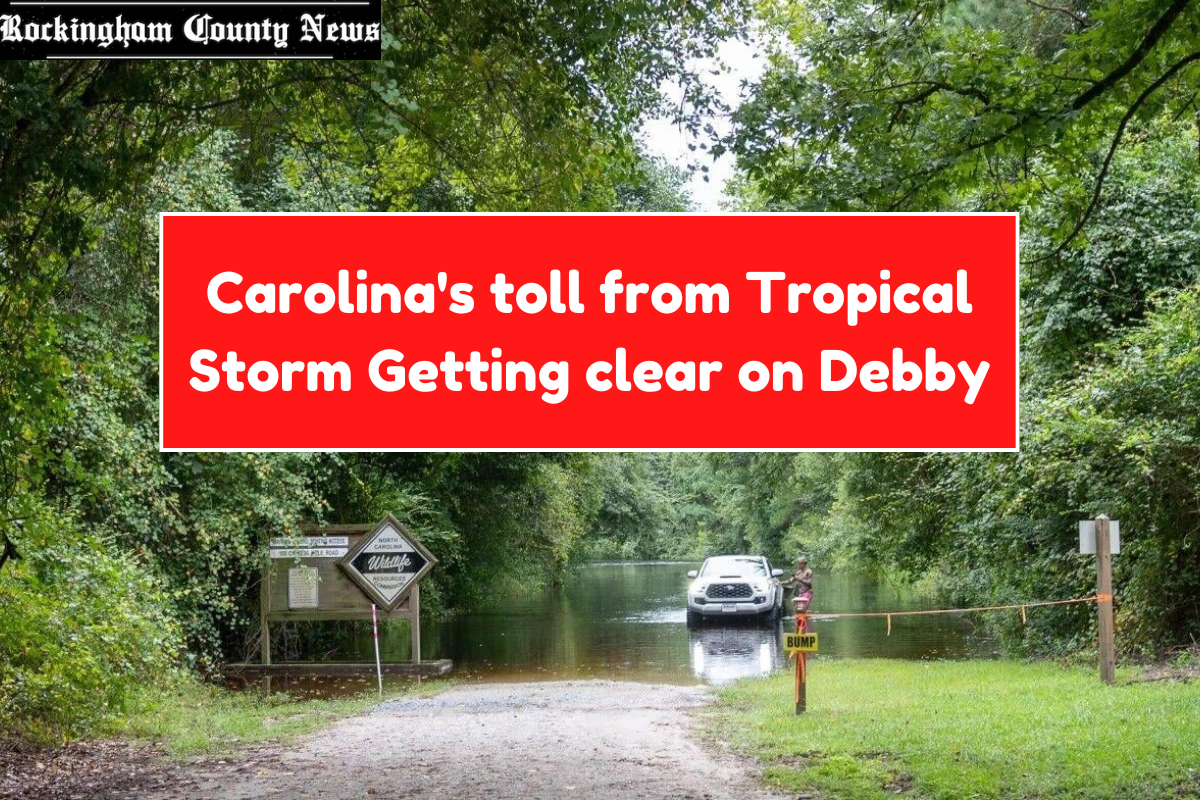Four people have died in North Carolina because of Tropical Storm Debby, according to Justin Graney, who is in charge of media for North Carolina Emergency Management and spoke to Carolina Public Press on Monday morning.
The deaths happened in Wilson County because of a tornado, in Rockingham County because of a falling tree, in Wake County because of a car accident, and in Robeson County because of floods washing a car off the road.
Some counties are still figuring out how bad the damage is, while others can’t even start because the flooding is still going on. How much state and federal help is given for recovery will rest on the results of these assessments.
In an email, Graney said, “It will take some time before the facts about the costs and help are clear.”
In some places, the water was pretty bad, but it didn’t last long after Debby left the state early Friday morning. That’s what happened in Chatham County, which is home to parts of both the Deep River and the Haw River. These rivers meet further downstream to form the Cape Fear River.
Chatham County’s emergency management director, Steve Newton, told CPP that there were no deaths or rescues related to the storm, even though there was a lot of flooding and fast-moving water that washed over islands in the Haw River near the historic mill village of Bynum, which is a short distance north of Pittsboro.
A member of the CPP news team saw a lot of locals and some people from farther away walk past the warning tape and onto the old footbridge at Bynum to get a better view of the fast-moving river.
The town of Pittsboro said that Pittsboro Elementary School Road and the ditch below it were damaged nearby, close to Sanford Road.
The county is still figuring out how bad the damage is, and the road is still closed as of Monday. Newton did not plan to ask for state or government help with the cleanup, though.
What happened in Duplin County
What happened in Duplin County, to the east, could not have been more different. Heavy rains and streams coming in from upstream caused major floods along creeks and rivers.
The Northeast Fork of the Cape Fear River was at its highest point on Saturday, but Duplin County was still having some slight flooding on Monday. Over the next week, the water level is likely to slowly go down, which means that many side roads will probably still be flooded on Saturday.
Due to flooding in Duplin County, many roads are closed. Scotty Summerlin, the business director for Duplin County, told CPP that this means farmers may have to delay some of their work over the next week.
On Monday, things were the same in nearby Pender County. A public report from Pender County emergency management says that the Black River and Northeast Cape Fear are still causing floodwaters to rise in the county.
Officials in Pender County are waiting to see the full effects of the floods until the water level has gone down.
“We haven’t had to save anyone,” Brandi Clark, communications director for Pender County, told CPP. “But there are ponds in people’s front yards and major flooding along the highways.”
According to NOAA’s prediction
According to NOAA’s prediction, the water level in that part of the Northeast Cape Fear will rise to a peak on Tuesday morning at 16.5 feet, which is higher than the major flood stage of 16 feet in the area.
On top of the flooding that is already happening, some scattered thunderstorms may bring heavy rain later this afternoon. But later this week, storms should be less likely in southeastern North Carolina because cooler air is expected to move in.
This week, flooding in Robeson County that happened during and right after Hurricane Debbie has just kept going. This weekend, the Lumber River caused major flooding in the county on the border with South Carolina. The water levels are expected to peak on Monday and then slowly go down over the next few days.
Robeson County had some of the worst floods in the state. The Lumber River was expected to reach a second crest late Monday, thanks to more rain over the weekend. Flooding will be very bad until the end of the week.
Chris Campbell of Robeson County’s Soil and Water Conservation department told CPP, “It’s hard to tell how bad the damage is while the water is still there.”
“The drainage system in Robeson County was put in place in the 1950s.” During floods, many of the steam banks are washed away. This makes our streams less able to hold water and increases the amount of silt that builds up. The stream doesn’t hold as much water during the next storm.
This means the grain can’t be sold, even if it is picked on time.
Tammy McLeod, who is in charge of emergency management for the city of Lumberton, told CPP that no one had died inside the city lines because of the storm. Lumberton Rescue and EMS, on the other hand, said on Facebook Saturday night that a driver died in an unincorporated part of the county after driving their car into floods and being swept away.
The Black River flooded some areas near the unincorporated town of Tomahawk in nearby Sampson County. The water levels reached their highest point early Sunday morning.
The county’s director of disaster management services, Richard Sauer, told CPP that he doesn’t know of any deaths caused by the storm. But three people had to be saved by swift water rescue teams. Sauer said that in all three cases, people drove around roadblocks and signs that said the road was closed.
There was an EF-2 tornado in the Town of Harrells on Wednesday that destroyed two homes before the worst of the floods hit.
Sauer told CPP that there was no other major building damage to report as of Monday morning. However, the county has asked for help from the state to do more damage assessments this week.
Strong winds did more damage to crops in Sampson County than rising water.
“Fields have standing water,” said Zachary Parker, an extension worker for Sampson County. “But wind has definitely hurt the quality of some crops, like tobacco.”
Health hazards in the water
The most pigs are raised in Duplin County, which has farms with almost 2 million hogs. Floods that break through hog lagoons, which are big pits where farms store pig waste, are a big problem for the environment and public health.
The water level in hog ponds across Eastern North Carolina was already high when Debby got there because of the heavy rains in late July.
“Farmers can’t get out to pump water out of the hog lagoons because the fields are too wet,” Mark Seitz, an extension worker for Pender County, told CPP. “There hasn’t been an overflow yet, but it’s getting close, and they’re having trouble.”
The NC Department of Environmental Quality said on Monday that three hog ponds in Pitt County and one in Lenoir County did not have water levels that were acceptable after the storm.
The storm caused flooding on a big poultry farm in Robeson County. This causes similar, but not as serious, environmental concerns as flooding on hog farms.
Animal waste isn’t the only thing that could be a problem. 100,000 gallons of partly treated wastewater spilled into Calico Creek in Morehead City, which is on the coast of Carteret County.
Problems with sewer plants happened in both Brunswick County and Onslow County at the end of last week.
“All we can do is pray and hope that it stops raining,” Seitz said. It’s too bad that more storms are expected for Eastern North Carolina on Monday night.
“We are getting a double whammy when it comes to crop production,” Seitz said in Pender County. “We had eight weeks of drought.”
“I’d hate to think about how much flooding this area would be dealing with right now if there hadn’t been that drought.” It rained 20 inches in the last half of July. If the ground hadn’t been so dry, it would have been hard to handle the floods that happened during Hurricane Florence.















Leave a Reply